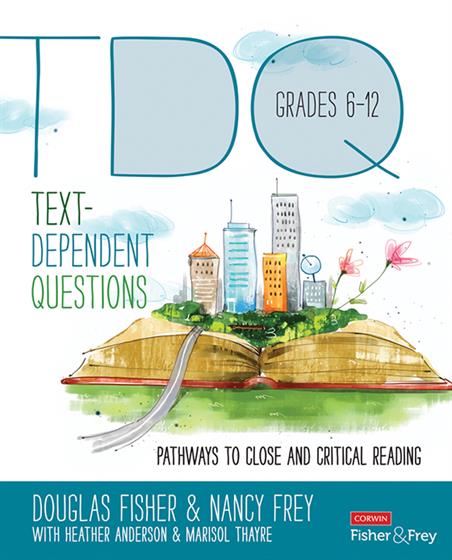
Hands-on, Practical Guidance for Educators
From math,
literacy, equity, multilingual learners, and SEL, to assessment, school counseling,
and education leadership, our books are research-based and authored by experts
on topics most relevant to what educators are facing today.
Text-Dependent Questions, Grades 6-12
- Grade Level: PreK-12
- ISBN: 9781483331379
- Published By: Corwin
- Series: Corwin Literacy
- Year: 2014
- Page Count: 328
- Publication date: September 02, 2014
Price: $39.95
For Instructors
When you select 'request review copy', you will be redirected to Sage Publishing (our parent site) to process your request.
Description
Fisher & Frey’s answer to close and critical reading
No doubt since the cave paintings of prehistoric times, humans have asked questions to make sense of the message. So what could possibly be new about posing questions about text?
Plenty . . . and with TDQ, Doug Fisher and Nancy Frey reveal it all. After one quick read, you will have learned all the very best ways to use text-dependent questions as scaffolds during close reading . . . and the big understandings they can yield, especially when executed the Fisher and Frey way. But that’s just for starters. Fisher and Frey also include illustrative video, actual texts and questions, examples from across content areas, and an online professional learning guide, making the two volumes of TDQ a potent professional development tool across all of K-12.
The genius of TDQ is the way Fisher and Frey break down the process into four cognitive pathways that help teachers “organize the journey through a text” and frame an extended discussion around it. Step by step, this approach ensures that in every close reading lesson, students are guided to consider explicit and implied meanings, and deeply analyze and appreciate various aspects of a text, especially those that may be challenging or confusing.
Here’s how the four inter-related processes play out, with every why and every how answered:
- What does the text say? (general understandings and key details)
- How does the text work? (vocabulary, structure, and author’s craft)
- What does the text mean? (logical inferences and intertextual connections)
- What does the text inspire you to do? (write, investigate, present, debate)
The cool thing? These questions ignite students’ engagement and discussion because they strategically lead students to a place of understanding where explicit and implied meanings and interpretations can be debated. Far from being overly literal or teacher-led, the questioning framework Fisher and Frey advance enhances the quality of student talk and idea-generation. All in all, there’s no better resource to cultivate students’ capacity for independent reading and incisive thinking.
Longtime collaborators and recipients of numerous teaching and leadership awards, DOUGLAS FISHER and NANCY FREY are Professors of Educational Leadership at San Diego State University as well as teacher leaders at Health Sciences High & Middle College.
Author(s)

Douglas Fisher
Douglas Fisher is professor and chair of educational leadership at San Diego State University and a leader at Health Sciences High and Middle College. Previously, Doug was an early intervention teacher and elementary school educator. He is a credentialed teacher and leader in California. In 2022, he was inducted into the Reading Hall of Fame by the Literacy Research Association. He has published widely on literacy, quality instruction, and assessment, as well as books such as Welcome to Teaching, PLC+, Teaching Students to Drive their Learning, and Student Assessment: Better Evidence, Better Decisions, Better Learning.

Nancy Frey
Nancy Frey is professor of educational leadership at San Diego State University and a leader at Health Sciences High and Middle College. Previously, Nancy was a teacher, academic coach, and central office resource coordinator in Florida. She is a credentialed special educator, reading specialist, and administrator in California. She is a member of the International Literacy Association’s Literacy Research Panel. She has published widely on literacy, quality instruction, and assessment, as well as books such as The Artificial Intelligences Playbook, How Scaffolding Works, How Teams Work, and The Vocabulary Playbook.

Heather Anderson
Heather Anderson has a wide range of experience teaching at both the elementary and high school levels. She earned her M.A. in Curriculum and Instruction from San Diego State University, is BCLAD certified, has extensive experience in staff development, and spent part of her career as an elementary math specialist. Heather has shared her passion for education both nationally and internationally while presenting at conferences and consulting at individual school sites emphasizing the use of Gradual Release of Responsibility, differentiated instruction, close reading and collaborative grouping. Heather currently teaches English and higher level Spanish at Health Sciences High and Middle College, a charter school in San Diego.

Marisol Thayre
Table of Contents
Acknowledgments
Chapter 1. The Building Blocks of Effective Close and Critical Reading Lessons
Close Reading Defined
The Phases of Close Reading
How Much Frontloading Is Too Much (or Not Enough)?
Text-Dependent Questions Drive Close Reading
Use Text-Dependent Questions Judiciously
Question Yourself
Videos
Chapter 2. What Does the Text Say?
An Invitation to Read Closely: Literal-Level Questions
Why Students Need This Type of Questioning
Why Classroom Discussion Is Crucial
How Examining What the Text Says Addresses the Standards
Using Text-Dependent Questions About What the Text Says
Question Yourself
Practice Text: General Dwight D. Eisenhower's D-Day Invasion Statement to Soldiers, Sailors, and Airmen of the Allied Expeditionary Force, June 6, 1944
Videos
Chapter 3. How Does the Text Work?
An Invitation to Read Closely: Structural-Level Questions
Why Students Need This Type of Questioning
How Examining How the Text Works Addresses the Standards
Using Text-Dependent Questions About How the Text Works
Question Yourself
Practice Text: "Jabberwocky" by Lewis Carroll
Videos
Chapter 4. What Does the Text Mean?
An Invitation to Read Closely: Inferential-Level Questions
Why Students Need This Type of Questioning
How Examining What the Text Means Addresses the Standards
Using Text-Dependent Questions About What the Text Means
Question Yourself
Practice Text: "Instances of the Communication of Cholera Through the Medium of Polluted Water in the Neighborhood of Broad Street, Golden Square" by John Snow
Videos
Chapter 5. What Does the Text Inspire You to Do?
An Invitation to Read Closely: Action-Oriented Questions and Tasks
Why Students Need to Complete These Types of Tasks
How Examining What the Text Inspires You to Do Addresses the Standards
Using Text-Dependent Tasks About What the Text Inspires You to Do
Question Yourself
Practice Text: Excerpt From Introduction to A More Perfect Union: The Creation of the United States Constitution by Roger A. Bruns
Practice Text: The Bill of Rights: A Transcription
Videos
Coda
Appendices: Texts and Questions for . . .
Appendix I: High School English
Appendix II: Middle School English
Appendix III: High School Social Studies/History
Appendix IV: Middle School Social Studies/History
Appendix V: High School Science
Appendix VI: Middle School Science
References
Index
About the Authors
About the Contributors
Reviews
“Fisher and Frey set the record straight about text-dependent questions. They demonstrate that text-dependent questions can address not only literal understanding but also understandings about what the text doesn’t say, how the text works, what the text means to and for the reader, how the text might be read in a specific discipline, and more. With specific prompts and concrete examples, Fisher and Frey show us how to use questioning as a central tool to address the Common Core State Standards.”
NELL K. DUKE“Fisher and Frey set the record straight about text-dependent questions. They demonstrate that text-dependent questions can address not only literal understanding but also understandings about what the text doesn’t say, how the text works, what the text means to and for the reader, how the text might be read in a specific discipline, and more. With specific prompts and concrete examples, Fisher and Frey show us how to use questioning as a central tool to address the Common Core State Standards.”
University of Michigan
“Fisher and Frey have a knack for making complex topics accessible. They write in a jargon-free style that teachers appreciate, and their use of examples and analogies helps bring ideas to life. These are qualities their readers have come to expect, and this book does not disappoint. . . . Teachers will find here an abundance of fresh, practical ideas that are easy to implement. This book deserves a ‘close read,’ and I heartily recommend it."
MICHAEL MCKENNA“Fisher and Frey have a knack for making complex topics accessible. They write in a jargon-free style that teachers appreciate, and their use of examples and analogies helps bring ideas to life. These are qualities their readers have come to expect, and this book does not disappoint. . . . Teachers will find here an abundance of fresh, practical ideas that are easy to implement. This book deserves a ‘close read,’ and I heartily recommend it."
University of Virginia
“Doug Fisher and Nancy Frey are experts at linking research to educational practice. Their latest book, Text-Dependent Questions, provides teachers with the information they need to scaffold their students’ deep comprehension through four levels of questioning. I am excited to share this book with teachers and colleagues!”
LINDA DORN“Doug Fisher and Nancy Frey are experts at linking research to educational practice. Their latest book, Text-Dependent Questions, provides teachers with the information they need to scaffold their students’ deep comprehension through four levels of questioning. I am excited to share this book with teachers and colleagues!”
University of Arkansas at Little Rock
“Text-Dependent Questions solidifies Fisher and Frey’s well-earned reputation as literacy experts who offer sane and nuanced interpretations of the Common Core State Standards. They remind us that close reading at its best is a social process, one involving teacher-learner interaction as well as student-to-student talk. While the recommended texts and sample questions are useful, the extended classroom examples are the true heart of the book, demonstrating how skilled practitioners flexibly devise and deploy high-quality questions to serve varied instructional purposes. “
KELLY CHANDLER-OLCOTT“Text-Dependent Questions solidifies Fisher and Frey’s well-earned reputation as literacy experts who offer sane and nuanced interpretations of the Common Core State Standards. They remind us that close reading at its best is a social process, one involving teacher-learner interaction as well as student-to-student talk. While the recommended texts and sample questions are useful, the extended classroom examples are the true heart of the book, demonstrating how skilled practitioners flexibly devise and deploy high-quality questions to serve varied instructional purposes. “
Syracuse University
“Fisher and Frey deliver another indispensable resource for teachers of adolescents across the curriculum as they strive to meet today’s more rigorous standards. Mentoring students to grow from dependence on questions provided by others to developing the capacity to “interrogate a text” themselves is fundamental to proficient reading of complex disciplinary texts. Text-Dependent Questions provides teachers with a carefully reasoned pathway for questioning a text as a requisite for close reading.”
DOUGH BUEHL, Author of Classroom Strategies for Interactive Learning“Fisher and Frey deliver another indispensable resource for teachers of adolescents across the curriculum as they strive to meet today’s more rigorous standards. Mentoring students to grow from dependence on questions provided by others to developing the capacity to “interrogate a text” themselves is fundamental to proficient reading of complex disciplinary texts. Text-Dependent Questions provides teachers with a carefully reasoned pathway for questioning a text as a requisite for close reading.”
“Everything about this book is genuine. From the authors’ candid appraisal of the myths surrounding close reading to their forthright recommendations for teaching it is refreshing. Fisher and Frey have been there, lived the pedagogy, and generated much of the scholarship that makes Text-Dependent Questions both compelling and unpretentious. Readers who have heard this dynamic pair speak at conferences and other professional gatherings are in for a treat; they are indisputably on the frontline when it comes to engaging others in close reading.”
DONNA ALVERMANN“Everything about this book is genuine. From the authors’ candid appraisal of the myths surrounding close reading to their forthright recommendations for teaching it is refreshing. Fisher and Frey have been there, lived the pedagogy, and generated much of the scholarship that makes Text-Dependent Questions both compelling and unpretentious. Readers who have heard this dynamic pair speak at conferences and other professional gatherings are in for a treat; they are indisputably on the frontline when it comes to engaging others in close reading.”
Institute for African American Studies
For Instructors
When you select 'request review copy', you will be redirected to Sage Publishing (our parent site) to process your request.
Related Professional Learning
Related Signature ServicesRelated Resources
- Access to companion resources is available with the purchase of this book.

